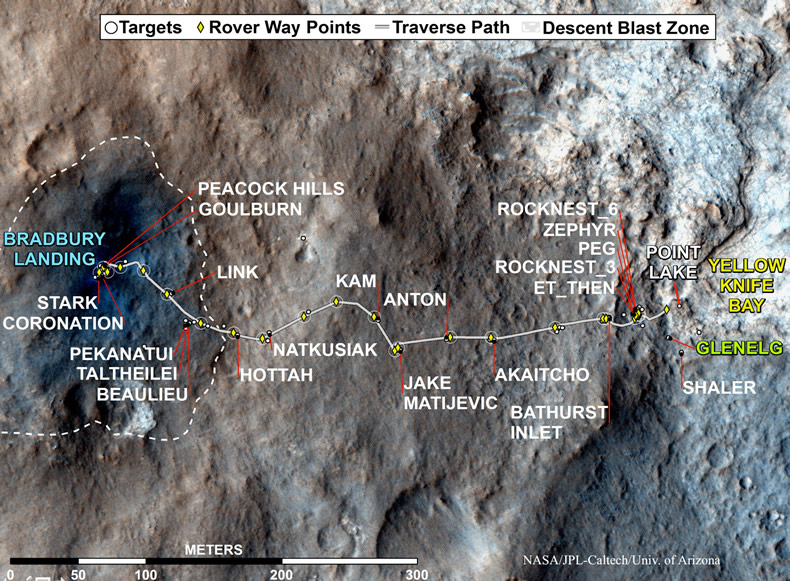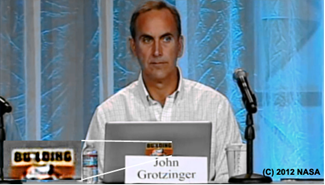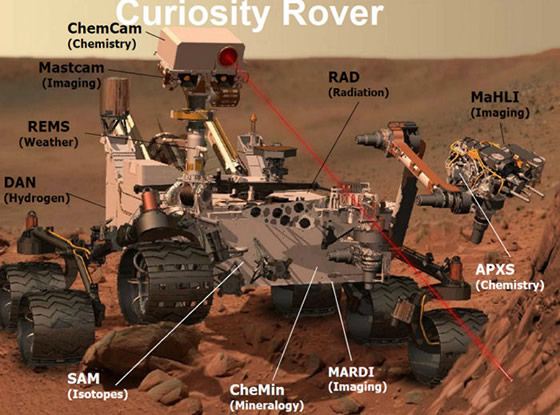NASA Goes "Apartment" Hunting

By Richard C. Hoagland
© 2012 The Enterprise Mission
At the annual American Geophysical Union (AGU) meeting, held in San Francisco, Monday, December 3, 2012, NASA quietly announced a “new target” for its Curiosity rover in the next few days – a curious set of “linear features,” surprisingly, located 90 degrees to its previous, months-long, relentless drive east (see map, above) … about 120 feet south of the rover’s current parked position.
These casually announced features could, in fact – unknown to 99.9% of those watching Curiosity’s on-going mission –irrevocably alter, not only the rest of the Mission itself--
But -- if the results of their extraordinary, imminent, analysis are made public (not an automatic certainty, by any means …) – those results will ultimately alter the lives of every human being on Earth.
This all began a couple weeks ago, with sudden attention drawn to a highly anticipated Monday morning AGU session -- where NASA was supposed to unveil, according to the hype, “a Curiosity discovery for the history books”; indeed, the Curiosity science team on Monday did announce the detection of “the first simple organic molecules (chlorinated methane) found on Mars” -- coming from Curiosity’s first instrument analysis of “the reddish sands of Mars” – an announcement that should have, indeed, made headlines around the world; confirmation of “organics” could be merely a prelude to potentially a much bigger announcement some day from this same Mission … confirmation of living organisms on Mars – either extinct … or currently extant! Instead, the Curiosity Team heavily qualified their “major announcement,” cautioning that “the ultimate source of these hydrocarbon molecules has yet to be determined ... they could just as easily, at this stage in the investigation, be the result of residual contamination brought from Earth ....”
Many observers now believe that the Curiosity scientists, at the last minute, "pulled their intended, major punch"; that – for whatever reason – the "historic discovery" the Team initially intended to announce December 3, abruptly, inexplicably, was dramatically underplayed … so that the media wouldn't turn it into headlines.
At the end of this "most peculiar session," Curiosity Project Scientist, Dr. John Grotzinger, looked ahead to the immediate, itinerary for the Mission:
"As we go down [from where we're currently parked – at a place we named 'Point Lake'] into an area called 'Yellowknife Bay,' we're going to stop at … at least one other outcrop that we've called 'Shaler' … It has a different expression [of features] ... it looks like something that has a much more finely-layered aspect to it than anything we've seen so far …
"And, we're going to work our way down in there … we're going to [I] guess … probably … this should happen in the next couple of weeks [emphasis added] …."
The startling implications behind this, on the surface, “routine mission decision” cannot be overstated; for, unknown to the media currently covering the mission, or (apparently) most of the scientists on the Team, the innocuous-sounding location “Shaler” – specifically cited by Grotzinger as the next destination of Curiosity--
Is none other than the precise location of the astonishing “Martian apartments” -- cited and discussed extensively by the Enterprise Mission on the national radio program, “Coast to Coast AM,” Saturday night, December 1 (below)!
| Below: The Curiosity "Apartments" Comparison with Destroyed Murrah Building in Oklahoma City. Note Regular Vertical Support Columns and 'Ragged' Horizontal Floors... |




